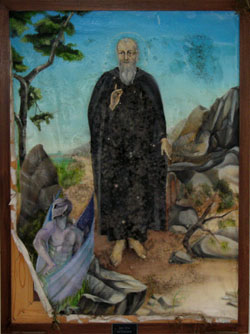
Feastday: September 26
Birth: 910
Death: 1005
Abbot Born in Calabria, southern Italy, to Greek parents, he spent a dissolute youth until deciding to enter the Basilian order after his mistress and their child died when he was about thirty years old. After living as a hermit for a time, he took up residence in several communities and finally was elected abbot over San Demetrio Corone. In 981, marauding Saracens threatened southern Italy, and Nilus fled with his monks to Monte Cassino. After spending fifteen years in the monastery of Vallelucio which had been given to the monks for their use, he founded a new community at Serpero. Later he received a grant of land from Count Gregory of Tusculum and so established the community which became the Monastery of Grottaferrata under Nilus' disciple St Bartholomew. Nilus died at Frascati on December 27.
Italian saintNilus the Younger, also called Neilos of Rossano (Italian: Nilo di Rossano, Greek: Όσιος Νείλος, ο εκ Καλαβρίας; 910 – 27 December 1005) was a monk, abbot, and founder of Italo-Byzantine monasticism in southern Italy. He is venerated as a saint in the Eastern Orthodox and Roman Catholic churches, and his feast day is celebrated on September 26 in both the Byzantine Calendar and the Roman Martyrology.
Biography
Born to a Italian family of Byzantine rite ("Greek rite") of Rossano, in the Byzantine theme of Calabria, for a time he was married and had a daughter. Sickness brought about his conversion, however, and from that time he became a monk and a propagator of the rule of Saint Basil in Italy.
He was known for his ascetic life, his virtues, and theological learning. For a time he lived as a hermit, but his reputation drew followers to Rossano, whom he began to instruct. However, after a while, he realized that he was viewed as a local authority, and hearing that there was talk of making him bishop, Nilus fled to Capua, where he stayed for fifteen years. Later he spent certain periods of his life at various monasteries which he either founded or restored. Although Nilus instructed his monks according to the Rule of St. Basil, he maintained cordial relations with the Benedictines at Monte Cassino, where he spent some time, as well as at the Alexius monastery in Rome. The Rule of St. Basil was one of the resources Benedict had recourse to when drafting his own rule.
When Pope Gregory V (996–999) was driven out of Rome, Nilus opposed the usurpation of Philogatos of Piacenza as antipope. According to his disciple and biographer, Bartholomew, in 998 Nilus hastened to Rome to intercede on behalf of a fellow native of Rossano, John Philogathos, who had, against the advice of Nilus, cooperated in an ill-advised scheme of the Roman noble Crescentius to depose the Emperor Otto III's kinsman, Pope Gregory V. Later when Philogathos was tortured and mutilated, Nilus reproached Gregory and the Emperor for this crime, prophesying that "the curse of heaven sooner or later would affect their cruel hearts".
Nilus main works were the foundation in 1004 of the famous Greek monastery of Grottaferrata, near Frascati, on lands granted him by Gregory, count of Tusculum; he is counted the first abbot. At the time Calabria was under the Byzantine rule and was Koine Greek in language, culture, and spiritual and liturgical tradition. The abbey continues in the Byzantine rite. He spent the end of his life partly in the Sant'Agata monastery in Tusculum and partly in a hermitage at Valleluce near Gaeta. He died in the Sant'Agata monastery in 1005.
Saint Nilus is revered as the patron saint of scribes and calligraphers.
Notes
- ^ "After a carefree youth in the south of Italy, he became a monk at the monastery of St Adrian in Calabria, where he later became abbot. In 981 the invading Saracens drove the monks to Vellelucio, where they lived on land given to them by the monastery of Montecassino. Shortly before his repose, Nilus designated that as the place where his monastery was to be definitively established. This monastery, of Grottaferrata, was for long faithful to Orthodoxy."
- ^ Territorial Abbey of Holy Mary of Gracem of Grottaferrata (Italian: Abbazia Territoriale di Santa Maria di Grottaferrata).

